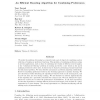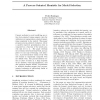105
Voted
ICML
1998
IEEE
16 years 1 months ago
1998
IEEE
We study the problem of learning to accurately rank a set of objects by combining a given collection of ranking or preference functions. This problem of combining preferences aris...
78
Voted
ICML
1998
IEEE
16 years 1 months ago
1998
IEEE
Relational reinforcement learning (RRL) is both a young and an old eld. In this paper, we trace the history of the eld to related disciplines, outline some current work and promis...
85
Voted
ICML
1998
IEEE
16 years 1 months ago
1998
IEEE
101
Voted
ICML
1998
IEEE
16 years 1 months ago
1998
IEEE
This paper presents a new approach to hierarchical reinforcement learning based on the MAXQ decomposition of the value function. The MAXQ decomposition has both a procedural seman...
109
click to vote
ICML
1998
IEEE
16 years 1 months ago
1998
IEEE
In this paper, we adopt general-sum stochastic games as a framework for multiagent reinforcement learning. Our work extends previous work by Littman on zero-sum stochastic games t...
102
click to vote
ICML
1998
IEEE
16 years 1 months ago
1998
IEEE
Computational comparison is made between two feature selection approaches for nding a separating plane that discriminates between two point sets in an n-dimensional feature space ...
111
click to vote
ICML
1998
IEEE
16 years 1 months ago
1998
IEEE
Predicting items a user would like on the basis of other users' ratings for these items has become a well-established strategy adopted by many recommendation services on the ...
105
Voted
ICML
1998
IEEE
16 years 1 months ago
1998
IEEE
Genetic Programming (GP) is a machine learning technique that was not conceived to use domain knowledge for generating new candidate solutions. It has been shown that GP can bene ...
101
click to vote
ICML
1999
IEEE
16 years 1 months ago
1999
IEEE
Lbr is a lazy semi-naive Bayesian classi er learning technique, designed to alleviate the attribute interdependence problem of naive Bayesian classi cation. To classify a test exa...
102
click to vote
ICML
1999
IEEE
16 years 1 months ago
1999
IEEE
Most machine learning algorithms share the following drawback: they only output bare predictions but not the con dence in those predictions. In the 1960s algorithmic information t...


